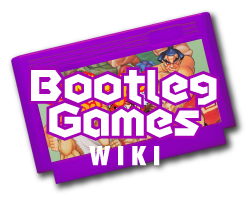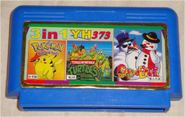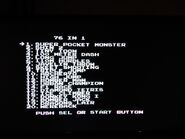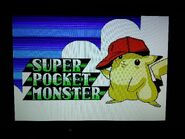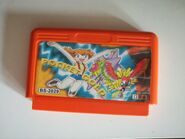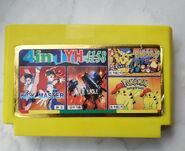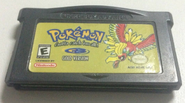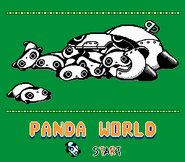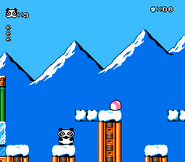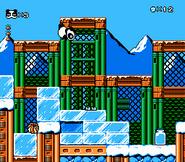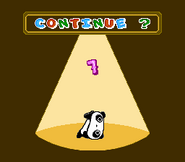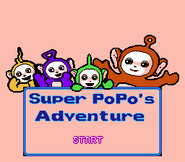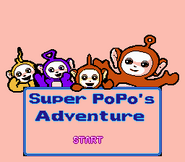(Unexisting link removed) |
No edit summary Tag: Source edit |
||
| (46 intermediate revisions by 25 users not shown) | |||
| Line 1: | Line 1: | ||
| − | {{About| |
+ | {{About|Pocket Monster (Famicom)|games with a similar title|Pocket Monster (disambiguation)}} |
{{Infobox game |
{{Infobox game |
||
| − | |name |
+ | |name = Pocket Monster |
| − | |image |
+ | |image = File:PocketMonsterTitle.png |
| − | |caption |
+ | |caption = Pocket Monster's title screen. |
| + | |publisher = [[Super Game (company)|Super Game]] |
||
| ⚫ | |||
| + | |developer = [[Gamtec]](?) |
||
| ⚫ | |||
| ⚫ | |||
| ⚫ | |||
| + | |date = 1997 |
||
| ⚫ | |||
| ⚫ | |||
}} |
}} |
||
| − | '''''Pocket Monster''''' is a |
+ | '''''Pocket Monster''''' is a NES platformer featuring Pikachu. It was also ported to the Game Boy Advance under the name ''Pokémon Gold Version''. |
== Overview == |
== Overview == |
||
| − | [[File: |
+ | [[File:Pocket Monster - Famicom - Gameplay.png|thumb|left|150px|''<nowiki>Pocket Monster'</nowiki>''s gameplay. Note that the background graphics are stolen from ''Athena'' and modified.]] |
| − | This is a simple platformer |
+ | This is a simple platformer, in which the player controls Pikachu. Compared to many other NES games, the controls are inverted, which means that jumping is done by pressing B, and pressing A while moving in a direction makes Pikachu run, and A on its' own clears every enemy on the screen. It's also possible to stomp on enemies, similarly to ''Super Mario Bros.''. Pikachu can take three hits before losing a life, with the number of hits left represented by a Poké Ball counter on the top left corner of the screen. There are a total of four worlds (Velbt, Woods, Tableland, and Motte) which are split into three levels each, as well as a single-screen boss battle at the end of each. This game has a debug mode enabled by default, allowing the player free movement while paused and to skip to the next level by pressing Select. In some places, the player can fall partway into the ground, although this doesn't have any implications. The music also glitches slightly at certain points. |
| + | [[File:Pocket Monster - Famicom - Ending.gif|right|150px|thumb|Ending screen.]] |
||
| − | The background graphics are mostly ripped and slightly modified from ''Athena'' and ''Adventure Island II''. Some of the enemies are also taken from various games, with some of them based |
+ | The background graphics are mostly ripped and slightly modified from ''Athena'' and ''Adventure Island II''. Some of the enemies are also taken from various games, with some of them based on ''Pokémon''. The sound engine was taken from ''Twin Bee'', a game published and developed by Konami, and, while the game has a soundtrack of its' own, all the sound effects are still recognizably from ''Twin Bee'' - a setup similar to what [[Super Game (company)|Super Game]] and [[Gamtec]] used to have. The ending is Pikachu dancing with an "End" message at the top of the screen. |
| ⚫ | |||
| − | [[File:PMEnd.gif|center|Ending screen.]] |
||
| − | |||
| ⚫ | |||
=== ''Panda World'' === |
=== ''Panda World'' === |
||
| − | This game was later hacked to make ''Panda World'', which plays very similarly aside from different level layouts and the electric shock attack |
+ | This game was later hacked to make ''Panda World'', which plays very similarly aside from different level layouts and the electric shock attack being replaced with the ability to throw snowballs, of which the player has a limited amount. Instead of Pikachu, the player controls a Tarepanda and this time around the debug mode now requires a cheat code to activate. Some of the background graphics are ripped from ''Mega Man 6''. |
=== ''Pocket Amethyst'' === |
=== ''Pocket Amethyst'' === |
||
| Line 26: | Line 28: | ||
=== ''Super Pocket Monster'' === |
=== ''Super Pocket Monster'' === |
||
| − | Another hack of this game was made, called ''Super Pocket Monster'', which is only known to exist on a 76-in-1 multicart. |
+ | Another hack of this game was made, called ''Super Pocket Monster'', which is only known to exist on a 76-in-1 multicart. The rest of the game is the same as the original. |
| − | === ''Super Popo Adventure'' === |
+ | === ''Super Popo's Adventure'' === |
| − | + | A hack based on the BBC children's series ''Teletubbies'', where you play as Po (erroneously referred to as Popo) going through levels to collect items for the other Teletubbies. It is only known to exist on ''[[150 in 1 Real Game]]'' and on a 401 in 1 console by Orb Gaming, which also features ''Pocket Monster'' and ''Panda World''. |
|
| + | |||
| + | == Trivia == |
||
| + | *The background music, along with sound effects, was later reused in ''[[Poke Tetris]]'', a ''Tetris'' clone featuring Pikachu and Jigglypuff. Two unused tracks would however be used as level themes in ''Panda World'' and ''Super Popo's Adventure''. |
||
| + | *"Velbt" is a misspelling of the word "Veldt" (also spelled "Veld") - a kind of field, usually present in South Africa, that's characteristic for being thinly forested but still having vegetation such as grass, bushes or shrubs. |
||
| ⚫ | |||
| ⚫ | |||
| + | *The backgrounds are taken from ''Athena'' for the NES. |
||
| + | *The title screen Pikachu in a cap is stolen from the ''Pokémon'' manga ''The Electric Tale of Pikachu''. |
||
| + | *In ''Super Popo's Adventure'': |
||
| + | **There is an unused ''Teletubbies'' logo stored with the graphics for the title screen, along with text saying "PUSH". The former was removed likely to avoid any copyright issues from the BBC, while the latter was likely supposed to appear next to the "START" text.<ref>https://tcrf.net/Pocket_Monster_(NES)#Super_PoPo.27s_Adventure</ref> |
||
| + | **When returning from watching a demo gameplay, Dipsy will sometimes turn red on the title screen. It is unknown why it happens; though it could simply just be a bug itself or a programming error. |
||
== Gallery == |
== Gallery == |
||
| + | === ''Pocket Monster'' === |
||
<gallery> |
<gallery> |
||
3-1.png|A 3-in-1 cart featuring ''Pocket Monster''. |
3-1.png|A 3-in-1 cart featuring ''Pocket Monster''. |
||
| + | IMG 20180103 184036.jpg|The menu of the ''76 in 1 multicart'' featuring ''Super Pocket Monster''. |
||
| + | IMG 20180103 184040.jpg|''Super Pocket Monster''<nowiki>'</nowiki>s title screen. |
||
| + | IMG_20180717_175332.jpg|Cartridge featuring Misty, Starmie, and Ho-Oh. |
||
| + | IMG 20190726 131919-0.jpg|Pocket Monster and Pokémon 2 in a 4-in-1 cartridge. |
||
| + | PokemonGoldVersion.png|The Game Boy Advance cartridge. |
||
</gallery> |
</gallery> |
||
| − | == |
+ | === ''Panda World'' === |
| + | <gallery> |
||
| − | *The background music was later reused in "''[[Poke Tetris]]''", a ''Tetris'' clone featuring Pikachu developed by [[Nice Code Software|Nice Code]]. |
||
| + | Panda World (Unl)-0.png|Title screen. |
||
| − | *This game may have been developed by [[Super Game]] as it uses the same sound engine as their previous titles. |
||
| + | Panda World (Unl)-7.png|Gameplay. |
||
| − | * 'Velbt' might be a mispelling of the word 'Veldt', which is some sort of wide field in southern parts of Africa. |
||
| + | Panda World (Unl)-2.png|Gameplay. |
||
| ⚫ | |||
| + | Panda World (Unl)-1.png|Continue screen. |
||
| ⚫ | |||
| + | </gallery> |
||
| + | |||
| + | === ''Super Popo's Adventure'' === |
||
| + | <gallery> |
||
| + | Super PoPo's Adventure (Unl) (As) !-0.png|Title screen. |
||
| + | Super PoPo's Adventure (Unl) (As) !-1.png|Ditto, but Dipsy is red. |
||
| + | </gallery> |
||
| + | |||
| + | == Reference == |
||
| + | <references /> |
||
{{Super Game Games}} |
{{Super Game Games}} |
||
[[Category:Games]] |
[[Category:Games]] |
||
[[Category:Famicom/NES games]] |
[[Category:Famicom/NES games]] |
||
| + | [[Category:Game Boy Advance games]] |
||
[[Category:Platform games]] |
[[Category:Platform games]] |
||
| + | [[Category:Gamtec]] |
||
[[Category:Super Game]] |
[[Category:Super Game]] |
||
| + | [[Category:1997 video games]] |
||
[[Category:Pokémon games]] |
[[Category:Pokémon games]] |
||
| + | [[Category:Teletubbies games]] |
||
| + | [[Category:Hacks]] |
||
Revision as of 14:50, 20 July 2021
- This article is about Pocket Monster (Famicom). For games with a similar title, see Pocket Monster (disambiguation).
Pocket Monster is a NES platformer featuring Pikachu. It was also ported to the Game Boy Advance under the name Pokémon Gold Version.
Overview
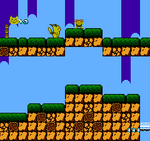
Pocket Monster's gameplay. Note that the background graphics are stolen from Athena and modified.
This is a simple platformer, in which the player controls Pikachu. Compared to many other NES games, the controls are inverted, which means that jumping is done by pressing B, and pressing A while moving in a direction makes Pikachu run, and A on its' own clears every enemy on the screen. It's also possible to stomp on enemies, similarly to Super Mario Bros.. Pikachu can take three hits before losing a life, with the number of hits left represented by a Poké Ball counter on the top left corner of the screen. There are a total of four worlds (Velbt, Woods, Tableland, and Motte) which are split into three levels each, as well as a single-screen boss battle at the end of each. This game has a debug mode enabled by default, allowing the player free movement while paused and to skip to the next level by pressing Select. In some places, the player can fall partway into the ground, although this doesn't have any implications. The music also glitches slightly at certain points.
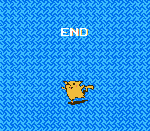
Ending screen.
The background graphics are mostly ripped and slightly modified from Athena and Adventure Island II. Some of the enemies are also taken from various games, with some of them based on Pokémon. The sound engine was taken from Twin Bee, a game published and developed by Konami, and, while the game has a soundtrack of its' own, all the sound effects are still recognizably from Twin Bee - a setup similar to what Super Game and Gamtec used to have. The ending is Pikachu dancing with an "End" message at the top of the screen.
Other Versions
Panda World
This game was later hacked to make Panda World, which plays very similarly aside from different level layouts and the electric shock attack being replaced with the ability to throw snowballs, of which the player has a limited amount. Instead of Pikachu, the player controls a Tarepanda and this time around the debug mode now requires a cheat code to activate. Some of the background graphics are ripped from Mega Man 6.
Pocket Amethyst
Just a simple title screen hack.
Super Pocket Monster
Another hack of this game was made, called Super Pocket Monster, which is only known to exist on a 76-in-1 multicart. The rest of the game is the same as the original.
Super Popo's Adventure
A hack based on the BBC children's series Teletubbies, where you play as Po (erroneously referred to as Popo) going through levels to collect items for the other Teletubbies. It is only known to exist on 150 in 1 Real Game and on a 401 in 1 console by Orb Gaming, which also features Pocket Monster and Panda World.
Trivia
- The background music, along with sound effects, was later reused in Poke Tetris, a Tetris clone featuring Pikachu and Jigglypuff. Two unused tracks would however be used as level themes in Panda World and Super Popo's Adventure.
- "Velbt" is a misspelling of the word "Veldt" (also spelled "Veld") - a kind of field, usually present in South Africa, that's characteristic for being thinly forested but still having vegetation such as grass, bushes or shrubs.
- The dancing sprite of Pikachu seen in the ending is also used in Puckman Pockimon when there are credits in the machine but only the first player is active. This and the sound engine cues imply that the game's developer might've had some ties with Gamtec.
- The Tarepanda from Panda World makes a cameo in one cartridge of The Panda Prince.
- The backgrounds are taken from Athena for the NES.
- The title screen Pikachu in a cap is stolen from the Pokémon manga The Electric Tale of Pikachu.
- In Super Popo's Adventure:
- There is an unused Teletubbies logo stored with the graphics for the title screen, along with text saying "PUSH". The former was removed likely to avoid any copyright issues from the BBC, while the latter was likely supposed to appear next to the "START" text.[1]
- When returning from watching a demo gameplay, Dipsy will sometimes turn red on the title screen. It is unknown why it happens; though it could simply just be a bug itself or a programming error.
Gallery
Pocket Monster
Panda World
Super Popo's Adventure
Reference
| List of games by Super Game |
|---|
|
Aladdin · BomberBoy · Boogerman · Earthworm Jim 2 · Mortal Kombat 3 · Pocahontas Part 2 · Pocket Monster · Super Lion King · The Super Shinobi |
